

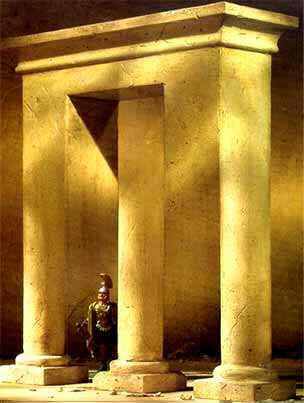
By James B. Calvert
Illusions are a natural part of consciousness
The Chain of Perception
Illusion and Hallucination
Optical Illusions
Illusions and Binocular Vision
Camouflage
Deliberate Illusions
Final Remarks
References
To Know More
The Author
The most remarkable thing in a remarkable universe is so commonplace that it is accepted without wonder or understanding. This is the appearance of reality and solidity that surrounds us when our eyes are open, which we call simply vision. Intellectual effort is required to realize that this seeming reality is within us, distinct for each individual, but so concordant with reality and with each other, and so stable, that it is accepted without question. The explanation for this wonderful aspect of consciousness is completely unknown.
The information that allows the mind to create and maintain this appearance is collected entirely by the visual system. When the eyes are closed, the appearance vanishes. At least, it does for me. Some people may be able to create realistic pictures with their mind's eye, but I cannot. I can still imagine my environment more or less accurately, but the vivid picture is gone.
The ability to make an accurate visual model of the external world is learned, not innate. The necessary materials are there at birth, of course, but they must be trained, or programmed, before the skill is perfected. This seems to be done in the first instance by comparing the chaotic impressions of light with the solid evidence of touch, which gives the perception depth and form. The visual sense ever after shows subtle indications of its origin in touch, though it becomes completely independent of touch after perfection. The ability to acquire this skill vanishes early in mental development. A person totally blind from birth whose vision may become normal at a later age can never make sense of the visual information and arrange it in a consistent manner.
There are three links in the chain of perception. The first is external and physical: the propagation of electromagnetic waves from the object to the eye. The second is the physical visual apparatus, from eye to brain, consisting of nervous tissue, although some important preliminary processing takes place. The third, and most complex, is the interpretation of the visual stimulus and the creation of the internal model of the world that is used by the consciousness.
In the third step, the visual stimulus received from outside is combined with information from the memory to create the picture. This is the most important part of vision, and how it is done is unknown. All the really interesting parts of vision occur here. The physical visual system from eye to brain has been studied in exquisite detail, its parts examined and described, and even the nerve impulses observed and measured, but all this gives no satisfying explanation of vision. It has been established, however, that important preliminary processing takes place here, including the differencing and the coding of stimuli. Coding is necessary to reduce the flood of information to a manageable amount. The visual system has a bandwidth problem, indeed.
The world picture must be constructed from incomplete information, in fact inferred from clues. The three-dimensional world is sensed by the two- dimensional retina, emphasizing the central role of depth clues. The picture depends on the unconscious recognition of objects, so that the remembered properties of objects can be transferred to those they seem to be on the basis of visual hints. Recognition is what gives vision its reality, showing the central role of mind.
A picture so assembled on the basis of partial information must be expected to occasionally be in error. The mind will always try to match stimulus and memory to create a picture. It will make what seems to be the most likely choice, and present that to the consciousness. An illusion occurs when the choice is incorrect. If a picture is created solely from memory, without visual stimulus (or with only a minimal visual stimulus) the result is hallucination, with which we shall not be concerned here, since it is a disorder of perception, not a normal or intended part of it. Things that are not there can also appear in illusion, it must be emphasized, but here it is normal.
An illusion can arise in any of the three links of visual perception. The mirage is an example of an external illusion, created in the first, physical link of light rays. It is visually interpreted as an actual scene, though we consciously recognize it as an illusion, and understand its cause. When we stare at a brightly illuminated red disk for a time, then transfer our attention to a white paper, we see a green disk as a result of what is called rather inaccurately fatigue. The green disk is an illusion created in the second partly physical, partly mental link. When the full moon is seen at the horizon, it seems much larger than when riding high in the sky, though physically it subtends exactly the same angle at the eye. This familiar illusion occurs in the third, mental link of vision, and a satisfying explanation of it is unknown.
Illusions occurring in the third link are those most generally recognized as optical illusions. Their scientific study began with J. Oppel in Jahresberichte des physikalisches Vereins zu Frankfurt, p. 138 (1854). Much work was done later in the century, but tapered off after 1900, although the subject is still actively researched by psychologists. Recent work deals largely with color and motion illusions, not on the static, black- and-white illusions that dominated earlier work. Popular interest in optical illusions has been sustained. The books by M. Luckeish (Visual Illusions, 1920), S. Tolansky (Optical Illusions, 1964), and M. Fineman (The Nature of Visual Illusion, 1981) are evidence of the continuing fascination. Each of these books gives references to further information. All theories of optical illusion in the third link are mere jejune speculation. Feel free to create your own theories; they will be as valid as those created by many a psychologist!
Sometimes a phenomenon is called an illusion when it really is not, but is simply a true picture of an unexpected observation. An example is the searchlight illusion described by Luckeish. The beam of a bright searchlight is visible because of scattering by dust and fog in its path, so that it seems practically a physical object. When the beam is projected up into the sky, it seems to vanish abruptly while still in full glory. When you look at this apparent end of the beam, you are looking in the direction in which the beam is pointed. If the beam were parallel (as your mind expects) it would, by perspective, narrow to a point. However, a searchlight beam is actually more or less divergent, fooling this expectation. It is only one's mental interpretation that is an illusion in this case, not the observation. Stars can be pointed out to others by means of a strong laser using this effect. If you view the searchlight beam from a distance, you see it diverge and become attenuated, and perhaps penetrating the layer of dusty air.
Optical illusions are badly named, since they are not unreal perceptions, but just misjudgments or ambiguous ones. The visual sense does the best it can to interpret the scene around us, but sometimes it fails. Two of the most striking failures are the stereoscopic perception of solid form on viewing a stereopair, and the appearance of continuous motion in the jerky image sequences of cinema. Both are pleasurable and desirable failures. Let us consider some more subtle ones in this article.
I recall with nostalgia and pleasure the many times I have watched a full autumn moon rise into the hazy evening sky over a wide eastern horizon. Its face is tawny, because the frequent inversions of autumn evenings hold the smoke of burning leaves close to the ground. She looks large, gigantic, larger than the trees and bluffs, or the houses and the highways. I think I should be able to see craters and mountains easily on the magnified disc, but I cannot. Sometimes even the familiar maria are hard to make out. The disc is round and seems perfectly circular, though I know it must be slightly flattened because of atmospheric refraction. As she rises, the haze is slowly left behind, and she becomes whiter and brighter, and the maria now look sharper. An hour or two later when I look, the moon is hard and bright and sharp, again in her normal celestial haunts after a visit to ours.
What I have seen is called the horizon illusion, known and remarked from antiquity. The rising moon seemed four times as large as the moon in the zenith. At first it seemed close, almost an earthly thing, but later its celestial nature took hold. Ptolemy explained that this was only apparent; the objective size of the moon was no different on the horizon than in the zenith. He said that although the celestial sphere was, indeed, a sphere, it appeared farther from the observer at the horizon, and bodies subtending the same angle appeared larger when presumed to be at a greater distance. A man at 1000 yards subtending the same angle as a man at 100 yards, would indeed appear to be a giant. It was the misjudgment of distance that caused the illusion. I feel that this explanation, though incomplete and unsatisfying, is still rather close to the best that can be said given our state of knowledge.
There have been very many explanations and analyses of the horizon illusion, many which accept Ptolemy's foundation, and seek to understand why distances to the horizon are misjudged, and others that look for some different cause. In fact, there is a book on the horizon illusion, and it has been the subject of more scientific papers than any other optical illusion. I will direct the reader to this voluminous literature for a deeper study, and only make some comments on the basis of my own observations.
When I see the moon near the horizon, it is clearly behind any objects I see there, clouds as well as houses and trees. Any object behind another is farther away and the moon is generally larger than anything else in sight in the distance. I do not know how strong the illusion is if, for example, the moon rises behind a uniform wall relatively close to me. I usually see it rising over vegetation and buildings. It looked remarkably large once when it rose behind a large office tower about a mile away, and was wider than that structure. The haze and creamy light help to make the moon seem a terrestrial thing, not the celestial body I know it is at a vast distance. The moon is, in fact, perceived as an earthly object, and in this guise can only seem gigantic. Constellations near the horizon share this expansion.
I seldom have seen the moon setting in the west in the dawn, since I usually sleep until well after the sun is up. I have done so, however, and my memory is that the moon appears pale in the cool, clear air. It seems a celestial body, and its size may be a little expanded, but nothing like in the autumn evenings. The red setting sun appears quite large and flattened, larger than the dawn moon, and sunspots are not visible, just as lunar detail is not visible in the haze. In the clear air of Wyoming, the sun sets into the Laramie Range as a brilliant ball I do not look at. My impression from glances is that it seems hard and bright. I conclude that the illusion is variable in strength, strongest in hazy air with subdued illumination, weakest in limpid air with bright light, and is mainly due to an unconscious assumption that the disc is a terrestrial object.
 Some illusions are caused by ambiguity in the scene. In 1860, Sinsteden noticed a remarkable thing about a windmill
seen in silhouette towards the darkening evening sky of the west. This view is represented to the left. It is unclear
whether the axis of the sails is directed away from you or towards you. The direction of rotation of the sails
depends on which is the case. Sinsteden and I can, by a conscious effort, imagine the scene in whichever way we
choose, and if we switch views, the direction of rotation reverses! This remarkable illusion can be shown here
through the magic of GIF animation. The absolutely exciting message of this illusion to me is that conscious thought
can change the perception, reinforcing my view that mental processing plays the essential role in vision; everything
else is auxiliary.
Some illusions are caused by ambiguity in the scene. In 1860, Sinsteden noticed a remarkable thing about a windmill
seen in silhouette towards the darkening evening sky of the west. This view is represented to the left. It is unclear
whether the axis of the sails is directed away from you or towards you. The direction of rotation of the sails
depends on which is the case. Sinsteden and I can, by a conscious effort, imagine the scene in whichever way we
choose, and if we switch views, the direction of rotation reverses! This remarkable illusion can be shown here
through the magic of GIF animation. The absolutely exciting message of this illusion to me is that conscious thought
can change the perception, reinforcing my view that mental processing plays the essential role in vision; everything
else is auxiliary.
A couple of years earlier, Schroeder had published a static ambiguous figure, shown in the middle below. This is a very famous illusion, still often shown. The red surface can either be to the front of the figure, or to the back. In one case a flight of stairs is shown, in the other something less common, perhaps stairs seen from below. As in the case of the Sinsteden illusion, one can go from one interpretation to the other by an effort of will. There are many other such ambiguous figures, including the intaglio faces that can be seen as faces in relief. The drawing procedure called isometric projection is very subject to ambiguity, since perspective gives no aid.
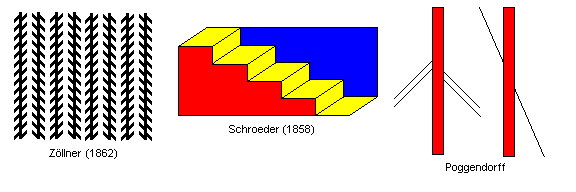
The figure on the left, due to Zöllner, shows the effects of contrast with the diagonal teeth on the parallel vertical bars. The bars seem anything but parallel! The method of drawing this figure affects the strength of the illusion, and the form shown is one of the strongest. However, the illusion occurs to some degree however the short diagonal elements are drawn. This illusion shows an error in estimation. The lines tend to become more parallel if you concentrate on a pair of them, but there is always some tension. When I look at the figure with both eyes, I also get a stereoscopic effect, as if it were corrugated. A related illusion is shown at the left below, where it should be noted that there are no inclined lines at all. These patterns should certainly be avoided in decoration!
 One of the most frequently mentioned illusions, called Poggendorff's illusion, is shown above at the right. His
name was probably chosen either to honour him, or because he suggested it at one time or another to an investigator.
It is fairly strong in the case on the left. The diagonal lines meet at the point where the left-hand side of the
vertical bar is crossed, but the right-hand lines seem too low. It is usually presented as shown at the right,
where the diagonal lines do not seem to be in the same straight line. The one on the right seems too low. This
tendency has been taken into account in the Union Flag of the United Kingdom, where the red saltire of St Patrick
is displaced so that it seems to be continuous on both sides of the cross of St George. This gives the flag a definite
top and bottom, which those unfamiliar with it usually reverse. There are many variants of Poggendorff's illusion.
One of the most frequently mentioned illusions, called Poggendorff's illusion, is shown above at the right. His
name was probably chosen either to honour him, or because he suggested it at one time or another to an investigator.
It is fairly strong in the case on the left. The diagonal lines meet at the point where the left-hand side of the
vertical bar is crossed, but the right-hand lines seem too low. It is usually presented as shown at the right,
where the diagonal lines do not seem to be in the same straight line. The one on the right seems too low. This
tendency has been taken into account in the Union Flag of the United Kingdom, where the red saltire of St Patrick
is displaced so that it seems to be continuous on both sides of the cross of St George. This gives the flag a definite
top and bottom, which those unfamiliar with it usually reverse. There are many variants of Poggendorff's illusion.
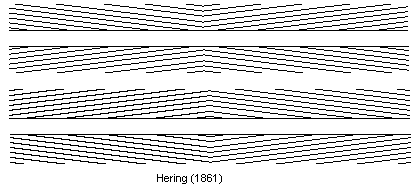
Another illusion of the same kind as Zöllner's was constructed by Hering, and is shown above in two forms. The horizontal parallels are seen bowed outwards in the top figure, and bowed inwards in the bottom figure.
Below are two more geometrical-optical illusions which came along later. In Bourdon's, the horizontal line seems bowed upwards. I do not perceive this illusion distinctly, but you may. Different people do not have the same responses to these illusions, again showing the intervention of the mind. In Loeb's illusion, the bottom of the two parallel lines on the right seems a bit higher than the top of the two parallel lines on the left, whereas in fact the two are in the same straight line.
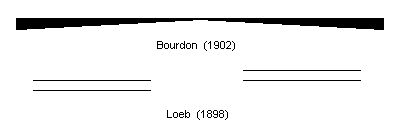
On the left below are two forms of the celebrated Müller-Lyer illusion, in which two lines of equal length seem unequal because of their surroundings. In both cases, the line ab is the same length as the line a'b', which seems a little longer.

On the right is an illusion due to Baldwin. The small cross is midway between the two discs, but the large disc seems to attract it a little towards itself. I do not find this a strong illusion.
 In
the figure on the right, the vertical line is the same length as the horizontal line. You may find this difficult
to believe, since the illusion is so strong, but measurement should convince you. This is called the top hat illusion, because it
is often illustrated by a top hat, in which the crown is as high as the brim is broad, but looks much higher. This
illusion gives clear evidence of the tendency to over-estimate vertical distances that makes hills ahead of us
seem steeper, and valleys deeper, than they actually are. It is, of course, completely distinct from the horizon
illusion with which this paper began, and the two are not related. Helmholz suggests sketching squares freehand
and then measuring them to see how strong the illusion is. My squares tend to be rather square, but there seems
to be an overestimation of about 1 part in 20.
In
the figure on the right, the vertical line is the same length as the horizontal line. You may find this difficult
to believe, since the illusion is so strong, but measurement should convince you. This is called the top hat illusion, because it
is often illustrated by a top hat, in which the crown is as high as the brim is broad, but looks much higher. This
illusion gives clear evidence of the tendency to over-estimate vertical distances that makes hills ahead of us
seem steeper, and valleys deeper, than they actually are. It is, of course, completely distinct from the horizon
illusion with which this paper began, and the two are not related. Helmholz suggests sketching squares freehand
and then measuring them to see how strong the illusion is. My squares tend to be rather square, but there seems
to be an overestimation of about 1 part in 20.
 The figure at the left, called the Kanisza square, shows that the impression of a square in front of the four circles
is one way the mind interprets the picture, which is really just four circles, each with a quadrant removed. The
square is not strongly or irresistibly perceived, the mind only offering it as a probable explanation for the figure.
You may notice that the mind may supply ghostly edges to the square to separate it from the background. This figure
was used in recent research with infants (Science, around November 2000) to find out the age at which different
elements are combined to form a recognizable object. The age was determined as about 7 months after birth, on the
basis of brain activity recorded electrically. This demonstrates yet again that perception is learned, not innate.
The figure at the left, called the Kanisza square, shows that the impression of a square in front of the four circles
is one way the mind interprets the picture, which is really just four circles, each with a quadrant removed. The
square is not strongly or irresistibly perceived, the mind only offering it as a probable explanation for the figure.
You may notice that the mind may supply ghostly edges to the square to separate it from the background. This figure
was used in recent research with infants (Science, around November 2000) to find out the age at which different
elements are combined to form a recognizable object. The age was determined as about 7 months after birth, on the
basis of brain activity recorded electrically. This demonstrates yet again that perception is learned, not innate.
Other classes of illusions are concerned with contrasts in illumination, irradiation, and very frequently, with colour. Some of these have physical explanations, but most still involve mental processing.
A practical reason for studying optical illusions is to understand how to counteract their unwanted effects. In classical Greek temple architecture, columns were expected to look evenly tapered, and architraves straight and level, to an observer standing before the building. However, columns appear slightly concave, and the architraves appear to sag. Therefore, columns were deliberately made slightly convex, an effect called entasis, and architraves slightly bowed, to counteract this tendency. The displacement of the saltire of St Patrick in the Union Flag is another example.
 Let's look at some classic static illusions created by black-and-white figures. All are third-link illusions resulting
from a failure of estimation, or from the faulty comparison of distances or objects. In the bisection illusion,
the vertical line is the same length as the horizontal line it bisects, though it seems about 25% longer. The illusion
persists if the figure is rotated 90°, so it is not due to asymmetry of the retina, as one witless psychologist
asserted. In the Müller-Lyer illusion, the line is bisected by the center arrowhead. The segment with the
diverging wings appears longer, but it is not. In the annulus illusion, the area of the central disk is equal to
the area of the annulus surrounding it, though it appears greater. Distance b-c in the lozenge illusion is equal
to distance a-b, though appearing significantly longer. In the curvature illusion, all three arcs have exactly
the same radius of curvature. Poggendorff's illusion is very famous. Line 2 is actually the continuation of the
line on the left, although line 1 appears to be. This illusion is counteracted in the British Union Flag by displacing
the arms of St. Patrick's cross on either side of St. George's cross so they appear to be in the same line. Greek
temples were designed with deliberate distortions to make the building appear correctly. Columns were given entasis, a slight swelling in
the middle, so they would look straight, and architraves were cambered up slightly in the center so they would
appear straight. Modern buildings are not so sensitively designed.
Let's look at some classic static illusions created by black-and-white figures. All are third-link illusions resulting
from a failure of estimation, or from the faulty comparison of distances or objects. In the bisection illusion,
the vertical line is the same length as the horizontal line it bisects, though it seems about 25% longer. The illusion
persists if the figure is rotated 90°, so it is not due to asymmetry of the retina, as one witless psychologist
asserted. In the Müller-Lyer illusion, the line is bisected by the center arrowhead. The segment with the
diverging wings appears longer, but it is not. In the annulus illusion, the area of the central disk is equal to
the area of the annulus surrounding it, though it appears greater. Distance b-c in the lozenge illusion is equal
to distance a-b, though appearing significantly longer. In the curvature illusion, all three arcs have exactly
the same radius of curvature. Poggendorff's illusion is very famous. Line 2 is actually the continuation of the
line on the left, although line 1 appears to be. This illusion is counteracted in the British Union Flag by displacing
the arms of St. Patrick's cross on either side of St. George's cross so they appear to be in the same line. Greek
temples were designed with deliberate distortions to make the building appear correctly. Columns were given entasis, a slight swelling in
the middle, so they would look straight, and architraves were cambered up slightly in the center so they would
appear straight. Modern buildings are not so sensitively designed.
There is no satisfying explanation for any of these illusions, or even of the reasons why they should exist. Depth clues are not involved in any of them, at least obviously, or ambiguous or incomplete information. They can, however, be recognized and classified, and have some practical application.
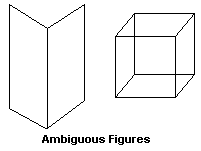 Sometimes a view may not contain enough information for the mind to make a conclusive interpretation. Where there
are only two reasonable interpretations, the mind may alternate them, as if unable to make up its mind. The rate
of alternation gives some idea of the length of time between reconsiderations of input data by the visual system,
or of the operation of the short-term memory that is so necessary to avoid overload in the face of the flood of
information bombarding the mind.
Sometimes a view may not contain enough information for the mind to make a conclusive interpretation. Where there
are only two reasonable interpretations, the mind may alternate them, as if unable to make up its mind. The rate
of alternation gives some idea of the length of time between reconsiderations of input data by the visual system,
or of the operation of the short-term memory that is so necessary to avoid overload in the face of the flood of
information bombarding the mind.
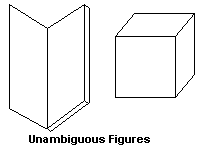 In the ambiguous figures shown, the one on the left can be interpreted either as an open book, or as a folded card
with the fold towards you. The cube can be interpreted either with the diagonal line in the lower left-hand corner
out of the page, or behind it. Vision is not really fooled here; there is simply insufficient depth information
for a conclusive choice. Modifying the figures to give better depth clues, as shown, makes the interpretation unique.
In one case, the figure was made to resemble a definite object, an open book, and in the other hidden lines were
removed to make the cube appear solid.
In the ambiguous figures shown, the one on the left can be interpreted either as an open book, or as a folded card
with the fold towards you. The cube can be interpreted either with the diagonal line in the lower left-hand corner
out of the page, or behind it. Vision is not really fooled here; there is simply insufficient depth information
for a conclusive choice. Modifying the figures to give better depth clues, as shown, makes the interpretation unique.
In one case, the figure was made to resemble a definite object, an open book, and in the other hidden lines were
removed to make the cube appear solid.
 Illusions can also arise from contrast of brightness, as the perception strives to maintain line and shade. The
well-known illusion shown at the right is an example. There are gray patches at every crossing, except for the
one you are looking at directly. This effect is something to avoid when designing linoleum.
Illusions can also arise from contrast of brightness, as the perception strives to maintain line and shade. The
well-known illusion shown at the right is an example. There are gray patches at every crossing, except for the
one you are looking at directly. This effect is something to avoid when designing linoleum.
Illusions of motion and color are difficult to illustrate in text, and are so extensive as to require individual study. Color can be perceived in a rotating black-and-white disc of suitable pattern, which is probably due to different fatigue characteristics of the color-sensitive proteins in the cone cells of the retina. Many color illusions are due to physical causes, because of the poor spectral resolution of the eye, and differences in illuminants and pigments. Adaptation, where the ambient illumination comes to appear as white as possible, and color constancy, where colors are interpreted similiarly under different conditions of illumination, are fundamental and useful properties of the color sense, not illusions.
Stereoscopic binocular vision is a remarkable facility that provides many interesting illusions, mostly useful and entertaining ones. When both eyes are fixated on the same nearby object, the images on the two retinas are not identical and conflict, since each eye sees the object from a different position. Detecting the conflict, the mind checks to see if the conflict can be explained by the different positions of the eyes, and if so, immediately interprets the object as located in the proper position in space. The two images are then said to have fused. Of all depth clues, the mind regards stereoscopy as superior, overriding all other clues. Stereoscopic vision is most effective in the same regions as human hands work, and must be considered predominantly as an aid to such activities. Accommodation and convergence of the axes of vision may play a part in stereoscopy, but image conflict is the primary cause, as was realized by Charles Wheatstone, the first to study stereoscopy around 1838.
When the conflicting images cannot be explained in this way, rivalry occurs instead of fusion, resulting in rejection of one image, alternation of images, or double vision. When sufficiently addled by alcohol, the mind may not feel like exerting the effort required for fusion. When the image in one eye is markedly poorer than the image in the other, it is usually suppressed, and the image from the good eye governs. If red is presented to one eye, and green to the other, rivalry results, in my perception, in an intermediate state than cannot be described as either color or any mixture of them. This allows stereoscopic views to be presented to the eyes separated by colored lenses without color conflict.
The stereoscopic illusion is the fusion of two scenes presented separately to the two eyes into one three-dimensional scene. The feeling of three dimensions is very strong, so that viewing such stereopairs is quite pleasant. When the two views are printed on a page about 65 mm apart, a normal interocular distance, a trained observer can fuse them by simply diverging her optic axes as if viewing a distant object. When this is done, the fused image appears between the two original images, so three images are actually seen. This is more easily done by the older observer, since accommodation of the eye does not hinder fusion when the axes are diverged. To allow larger stereopairs, and to help untrained observers, stereoscopes using prisms and lenses were invented. The common stereoscope was invented by David Brewster, and has now been reduced to spectacles with prism lenses. If the two scenes are presented in different colors, they can be printed on the same surface and separated by glasses with colored lenses, as mentioned above. Such stereopairs are called anaglyphs.
The strength and independence of the stereoscopic facility is shown by the lately-discovered fact that it is fully effective even when an object cannot be recognized, provided only that corresponding points can be identified in the two views. A stereopair can be made with random dots, identical except for small displacements that would occur if they were located on a three- dimensional surface. Such pairs can be fused, and the shape of the imaginary surface made visible in three dimensions. This clearly shows that memory plays no essential role in stereoscopy, in contrast to the major role it plays in all other visual interpretation.
A related type of stereogram consists of cunningly arranged areas in a single picture, often only small dots, such that each area does double duty, as a point of an object for each eye at the same time, but on different objects. These stereograms fuse when the optic axes are made parallel, so the areas do their intended double duty. The picture appears only upon fusion, and cannot be perceived in advance. The same thing happens if the optic axes are over- converged, but the stereoscopic effect is inverted (depth is reversed). These single-image random-dot stereograms are generally called autostereograms. These stereograms attracted great public interest in the early 1990's, when they were published in newspapers and books, and even appeared in outdoor advertising. Viewing autostereograms is excellent practice for learning how to fuse stereograms without aid, called free fusion.
 Tricking
the eye into recognizing one thing while observing another is often very useful to living things. There are three
different ways to do this. First, one might mimic something dangerous or nasty-tasting, as does the fly who resembles
a wasp, a brightly-colored butterfly, or an armed, uniformed policeman. Another way is to merge with the background,
as do moths, stick insects, tabby cats, or wealthy people wearing old clothes in the street. An interesting way
to do this is to break up a familiar outline by a contrasting pattern. Warships were painted in bold, zig-zag patterns
in the First World War for this purpose. The patterns did indeed break up the outline when you were close enough
to see that they were ships, but at large distances aerial perspective (blue haze) smoothed the pattern, revealing
again that they were ships. The third way is to look like something else. Cylindrical snakes and lizards are dark
on top and light on the bottom, contrary to the normal modelling of a cylinder, so they resemble flat objects containing
no meat.
Tricking
the eye into recognizing one thing while observing another is often very useful to living things. There are three
different ways to do this. First, one might mimic something dangerous or nasty-tasting, as does the fly who resembles
a wasp, a brightly-colored butterfly, or an armed, uniformed policeman. Another way is to merge with the background,
as do moths, stick insects, tabby cats, or wealthy people wearing old clothes in the street. An interesting way
to do this is to break up a familiar outline by a contrasting pattern. Warships were painted in bold, zig-zag patterns
in the First World War for this purpose. The patterns did indeed break up the outline when you were close enough
to see that they were ships, but at large distances aerial perspective (blue haze) smoothed the pattern, revealing
again that they were ships. The third way is to look like something else. Cylindrical snakes and lizards are dark
on top and light on the bottom, contrary to the normal modelling of a cylinder, so they resemble flat objects containing
no meat.
 A
picture drawn on a flat background is an attempt to trick the eye into perceiving a three-dimensional scene. This
is very effective, since the eye must do something similar in its normal functioning, becauseerful is perspective
drawing.
A
picture drawn on a flat background is an attempt to trick the eye into perceiving a three-dimensional scene. This
is very effective, since the eye must do something similar in its normal functioning, becauseerful is perspective
drawing.
In moving pictures, the mind interprets the succession of static frames as continuous motion, again something it must do in its normal functioning. There must be a temporal element in sensing a changing world, which is revealed by the flicker frequency, the rate above which continuous motion is perceived instead of jumps, of about 20 to 30 Hz. We are very thankful for these illusions (if we realize what they are) and are glad to have them.
Conjurors, three-card monte men, swindlers, mediums, priests, and others interested in influencing people sometimes make effective use of visual (and other) illusion. Stage magicians who are only concerned with entertainment call themselves illusionists to make it clear what they do, and to distinguish themselves from those who ascribe their wonders to spirits or chemicals. Illusionists, and the the other sorts of entrepreneurs, mainly use other kinds of illusions, but optical illusions are not ruled out. These procedures have been perfected through centuries and even millenia of profitable use, and remain evergreen owing to the continuous copious production of fools.
A curious illusion shows how the mind does its best to interpret its data. Fixate on a finger resting on a book at normal reading distance from your eyes. Now move the finger toward your eyes, keeping your fixatin on the page of the book. As soon as your finger is far enough from the page that what is obscured from the right eye is seen by the left, and vice-versa, it will become transparent, and you will see the book unobstructed by the finger. The finger is surely there, right in the way, but it is suppressed, probably because your fixation shows you are looking at the book, not the finger.
Illusions show that visual perception is much more complicated than was ever imagined in primitive views of it. One early view interpreted sight as touching by visual rays from the eye in the presence of activating rays from the source of light. More recently, the eye was perceived as a camera making a picture that was viewed somehow by the brain. The most interesting aspects of vision are, however, yet unexplained.
James. B. Calvert
Associate Professor Emeritus of Engineering, University of Denver, Denver,
CO, USA.
jcalvert@du.edu
This paper is a composition of two original papers published by Dr. Calvert in his site:
Optical Illusions: http://www.du.edu/~jcalvert/optics/illus.htm
Illusion: http://www.du.edu/~jcalvert/optics/illusion.htm